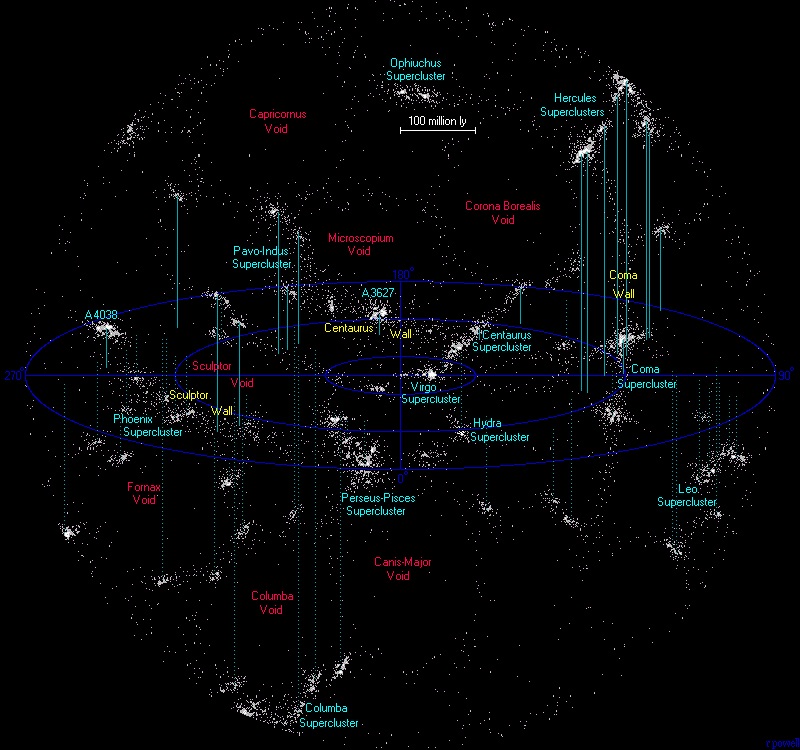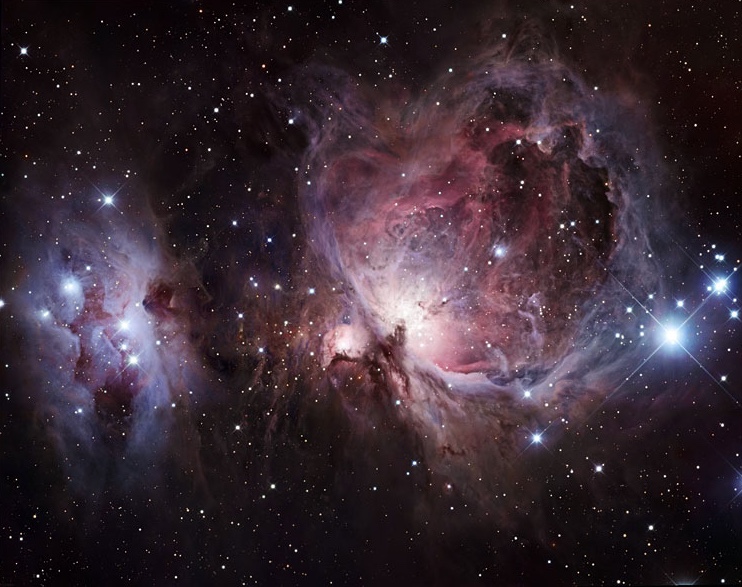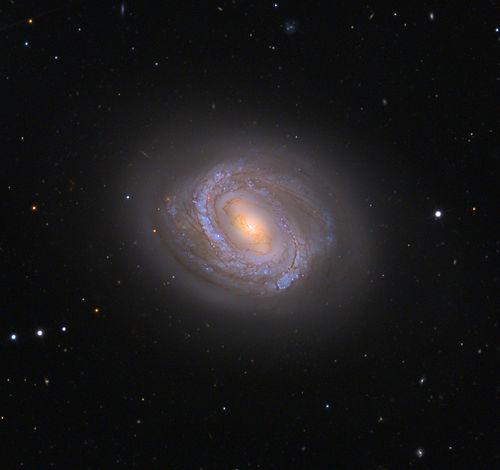The original question was: Is there any location in intergalactic space which is so far away from anyplace that it would be impossible to see anything with normal naked eye vision? No stars, but no galaxies, no nothing — just an empty void in all directions?
In other words, the middle of nowhere — the loneliest place in the universe.
Physicist: Yup! A bunch of them. They’re called cosmic voids.
The matter in our universe arranges itself in huge sheets and filaments of galaxy clusters wrapped around vast empty bubbles, like bread or a sponge. Even inside of galaxies space is almost completely empty; on the order of 1 atom per cubic centimeter and a star every few lightyears. But in the void between those galaxies, there is as close to nothing as you will ever find. The largest voids are on the order of a billion lightyears across.

A map of the fairly-local universe: stuff within about half a billion light years in every direction. Our galaxy is in the center of this map, but the scales here are so large that each dot is a cluster of many galaxies.
Only folk inside galaxies get starry skies, so the sky in every direction around you would boast a distinct lack of stars. But the question remains: could you see the galaxies that make up the walls of the void? Fortunately, the legwork (eyework?) for determining what is and isn’t visible to the naked eye has been done. Using naked eyes.
In the 1770’s comet-hunting was a hip thing for the telescope-wielding wealthy of Europe to do. Messier (who pronounced his name “Messy A”, because he was French) was tired of getting excited about the same set of barely-visible blurs night after night, so he wrote down everything he could see that definitely was not a comet and where it could be found. Incidentally, Messier did find some comets, but those discoveries are completely forgettable compared to his list of things you can see. The Messier Objects are are not stars, not comets, and not moving. That leaves a lot of stuff, all of which looks like a smudge or wisp of cloud, including: nebulae (“giant space smoke”), globular clusters (dense knots of stars of our galaxy), and farthest away, nearby galaxies.

M42, The Orion Nebula, is 1300 light years away (well inside of our galaxy). This appears about twice the size of the Moon in the sky and can easily be mistaken for a cloud. Just so you can find it: this picture is the sword in the Orion constellation.
The most distant galaxy visible to the naked eye is about 68 million light years away and fifty-eighth on Messier’s list: the ingeniously monikered M58. So, about 70 million lightyears is a reasonable upper-limit to how far away a galaxy can be seen by a person.

M58, a galaxy about 68 million light years away, appears to be about a sixth the size of the Moon in the sky. Under ideal circumstances it’s just barely visible to the naked eye as a tiny smudge.
Cosmic voids aren’t perfectly empty, just a lot emptier than the galaxy-laden regions of the galactic filaments. There is still the occasional “rogue galaxy” to be found drifting about. If you were in the middle of a void, and you turned off all the lights in your spaceship to let your eyes really adjust to the dark, you might be able to see the faintest smudge or two marring the black around you. If you had a reading-light on, you wouldn’t be able to see anything at all.
Our understanding of cosmic voids is growing rapidly, but there’s still a hell of a lot to learn. The base problem with astronomy has always been depth (i.e., the sky looks like it’s painted on a dome). A century ago we didn’t even know that other galaxies existed because we couldn’t tell the difference between globular clusters (dense groups of stars in our galaxy) and other galaxies (groups of stars explicitly not in our galaxy). Now we’re faced with a more subtle difficulty: it can be difficult to tell if a given galaxy is in the middle of a void or on the edges. An error of 5%-20% in the distance is not unusual on intergalactic scales and that can make it very difficult to determine exactly how empty a given void is.
If you were meandering about in the middle of a Cosmic Void, then you might perceive, at the very edge of your ability to see and under the best conditions, some of the galaxies in the walls of the void or the rare few in the void with you. The universe would appear to you as the interior of a hollow obsidian sphere, with a couple fingerprint smudges here and there.
This isn’t part of the question, but worth pointing at: where we are in the cosmic web.







The bigger question, the type that Einstein would ask. “What would it look like on a planet that is on the outer edge of the universe”. In other words, if we are on the planet around a star that is at the very edge of the universe… what would we see? A void on one side, and the stars and galaxies on the other. Is there an outer star? If so …. what is there on the edge …. In fact is there an edge?
@Clive Howard
One of the big fundamental ideas in cosmology is the “Cosmological Principle“: everywhere in the universe is more or less the same as everywhere else. In particular, there’s no edge and no center.
I really enjoyed this article. I’m in the process of writing extensively about this topic and was wondering if I might have your permission to use your image of “fairly local universe” and reference your article? Thank you, Dave
Every now and then one comes across a simple sounding sentence that causes one to re-examine one’s viewpoint.
‘The largest voids are on the order of a billion lightyears across.’
@David
It’s fine with me: I don’t own it either.
@The Physicist
“One of the big fundamental ideas in cosmology is the “Cosmological Principle“: everywhere in the universe is more or less the same as everywhere else. In particular, there’s no edge and no center.”
What if the observers were at the “edge” of a void? Then they would probably experience what Clive Howard said, “A void on one side, and the stars and galaxies on the other.” I can imagine a planet where one hemisphere is looking at the wonders of the sky while the other is looking at almost nothing
@Ivoudour
Effectively everything you can see in the sky are stars and nebulae inside of our own galaxy. Other galaxies look like blurs. If you were on the edge of a void and not in a galaxy, then I expect you’d see blurs on one side but not on the other.
@Clive Howard do you mean, “”If there’s a bright center to the universe, [what about] the planet that it’s farthest from”? Maybe it orbits a binary star? I’ll see myself out…;)
But… The latest information we are seeing says that we are actually in a void… Helping also to explain the discrepancy between the 2 different methods of measuring the hubble constant, cmb vs supernovas. Seems like there can be quite a bit of stuff in these “voids”. Seriously guys, this website is awesome!! Thank you for all the great answers!!
There is just one huge mistake, that cosmology principle is simply wrong when you say that there is no centre and that there is no edge, if the universe was created and expanded, than there is both centre and edge-facts.
Forget about the math since math will create concepts that do not exist in a real world, real-world evidences matter, not mathematical and statistical fictions.
@ Jefferson,
‘real-world evidences matter’
Please provide any real world evidence of the universe being ‘created’ (either by someone called ‘God’ or by a process called Big Bang) and/or real world evidence of expansion.
There isn’t any.
Expansion is a hypothesis to explain the ‘Red-shift’, which may be caused by something entirely different. EG Light goes slower when it encounters ’empty space’.
The only evidence of the Big Bang is that if the universe is expanding in all directions, and if we run the clock back then everything meets at a point some 13 or so billion years ago.
In the ‘Real-World’ the Unicorns had sexual congress with the Dragons and everything you see and experience is an outcome of the mind-blowing result.
@PJ London
That the universe is expanding (and therefore if you roll back time it must have been denser and hotter in the past) was the only evidence for the Big Bang 90 years ago. That alone is completely insufficient to convince astrophysicists that the Big Bang happened; they’re a persnickety bunch who, like all scientists, do not like other scientists’ theories. To be clear, there is a shocking amount of evidence from a wide range of scientific disciplines (well… sub-disciplines of physics and chemistry anyway). This guy does a decent job of talking about some of it.
“..The original question was: Is there any location …. impossible to see anything with normal naked eye vision?…”
As for one with little knowledge about the space, my reply to this:
IF there is such a location, it should be proved with normal naked eye vision observation, without using any tool, such as telescope etc. Otherwise, any answer to such a question remains as an assumption/theorem/whatever based on some theoretical mathematics or on some theoretical physics, that will draw some conclusions following some small signs by relating them using some similarity rules which we are used to on the earth in daily life. But, lately, especially after more chaos studies, we have been facing/learning broken similarities/symmetries more depending on the scales. So, by viewing the space by telescopes, things may not be as we theorized as telescopes/magnifiers are changing observed scales. To simplify all these with a simple example here, lets observe the air with our naked eyes. We cannot see any particle in the air with our nake eyes, but, there is, there are, dusts O2 Co2 N etc, so, does this mean the air itself here on this earth is a middle of nowhere as our naked eyes don’t see anything? Well, by inserting a magnifier between our eyes and the air, we start to see there are particles in the air and we relize we are not in the middle of nowhere. So, can we draw a similarity of this to the space and can we say there can be some materials actually in those void spaces mentioned in posts above? Yes and No. No, because we can/may not use same similarity between air and space as two mediums. Yes, because we use a tool in both cases, a magnifier/telescope/etc even if it doesn’t distort the observation, it is definitely a parameter, a factor, included in the scale change that may result in wrong conclusions. So, my conclusion/answer to this question above is that we never know unless we been to there.. heck, we even don’t know the air yet. Are we in the air really in materials or in a void.. Remembering that 99.9..% of atom is said to be empty/void, it is close to say 0.9999…=1 (ps. thanks for this site, i read almost all Q&A on right side of the page and learnt a lot.)
Almost every analogy I’ve read about the shape of the universe compares it to the surface of a balloon – which doesn’t make any sense. Does that mean the galaxies are all spread out on this spherical surface – with the theoretical centre of the sphere being where the big bang started? And doesn’t a surface imply an edge – where some guy on the outskirts of a galaxy looks straight up and sees nothing.